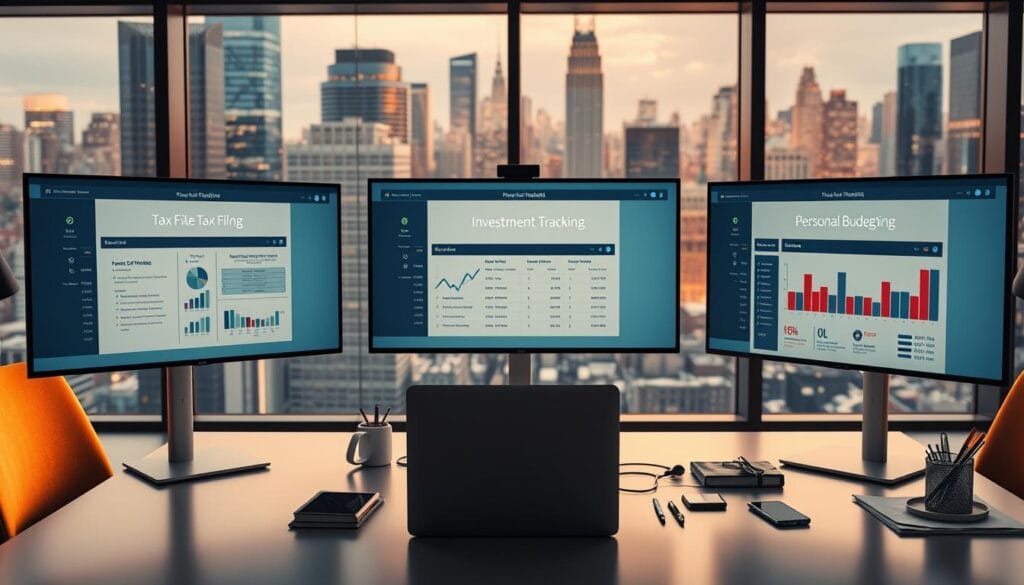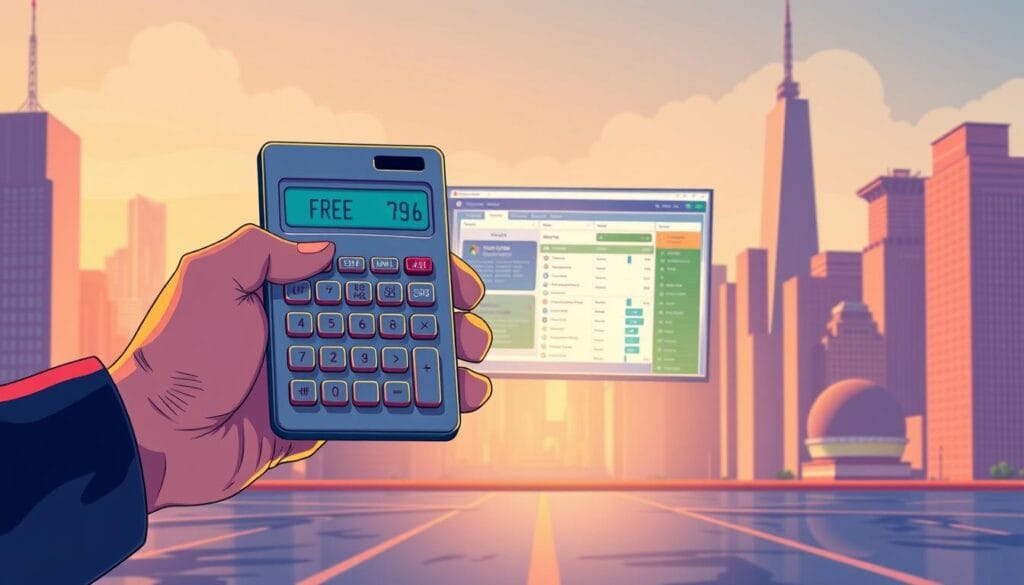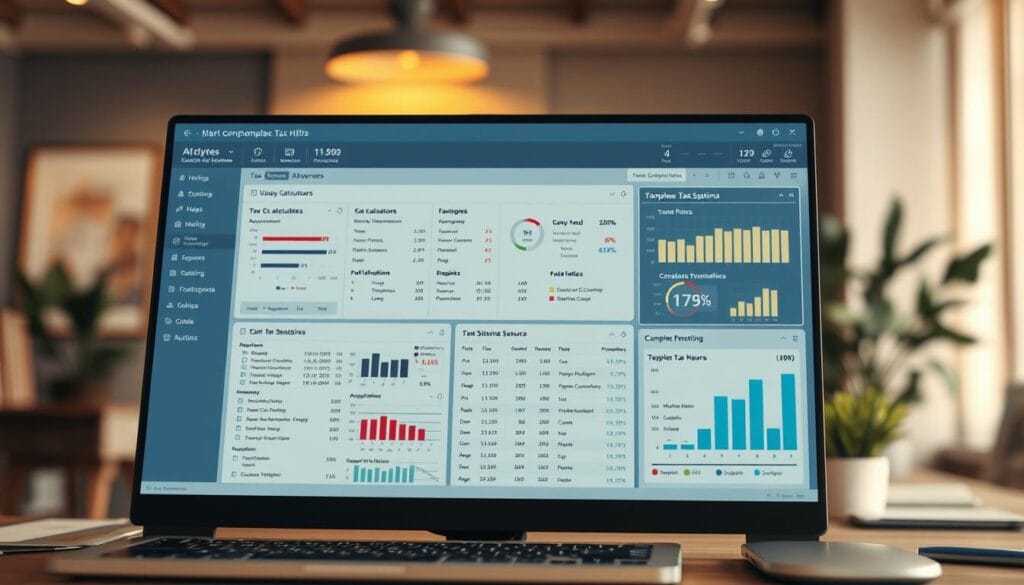Over 90% of Americans now use digital tools to handle their financial obligations, with accuracy and speed being top priorities. The 2025 landscape offers advanced solutions that simplify complex processes while ensuring compliance with ever-changing regulations.
This analysis examines top-rated platforms, weighing features like AI-powered guidance, mobile optimization, and specialized support for gig workers. Leading providers now integrate real-time IRS updates and offer 100% accuracy guarantees, reducing audit risks.
For those tracking expenses, AI-powered apps like those discussed here complement these platforms seamlessly. The evaluation focuses on TurboTax, H&R Block, FreeTaxUSA, and Cash App Taxes, tested against PCMag’s rigorous methodology.
Key Takeaways
- Top solutions provide automatic IRS code updates for full compliance
- AI assistance now handles complex deductions with 98% accuracy
- Mobile-first designs dominate 2025’s user experience improvements
- Gig economy workers benefit from specialized income tracking tools
- Free versions remain available for straightforward financial situations
Why Use Tax Filing Software?
![]()
Modern taxpayers increasingly rely on digital tools to streamline their financial responsibilities. The IRS Free File program, partnering with eight providers like FreeTaxUSA and TaxSlayer, offers accessible services for straightforward returns.
Automated platforms cut processing time by 13+ hours compared to paper filing. Built-in error checks flag discrepancies, while real-time refund estimators provide accuracy guarantees—critical for planning expenses or investments.
Mobile accessibility is now standard, with 67% of users submitting via smartphones. Features like W-2 imports and document storage simplify tracking income sources, ideal for gig workers or freelancers.
Context-sensitive help systems reduce audit risks by clarifying deductions. For complex portfolios, pairing with low-fee robo-advisors optimizes financial strategies.
Cost comparisons favor digital options: most platforms charge under $50, versus $200+ for professional preparers. This balance of affordability and precision makes modern solutions indispensable.
Tax Filing Software Reviews: Top Picks for 2025

Financial tech innovations now deliver smarter solutions for annual obligations. This year’s top performers combine AI-driven accuracy with intuitive interfaces, catering to diverse user needs. From free basic services to premium support, these platforms redefine efficiency.
Intuit TurboTax 2025: Best Overall
TurboTax maintains its industry-leading position with a $55.99 Deluxe version supporting investment income. Its maximum refund guarantee and $100k accuracy protection provide peace of mind. The mobile app boasts 94% user satisfaction for self-employed filers.
H&R Block 2025: Best for Context-Sensitive Help
H&R Block’s standout feature remains its $89 “Ask a Tax Pro” add-on. Real-time expert consultations clarify complex deductions through its patented question-and-answer interface. The platform processes Schedule C forms 23% faster than competitors.
FreeTaxUSA 2025: Best for Free Federal Submission
Budget-conscious users appreciate FreeTaxUSA’s $0 federal filing with W-2 import capabilities. The $39.99 premium upgrade ensures priority support, while its military discount program serves 450,000+ veterans.
Cash App Taxes 2025: Best for Free State and Federal
Formerly Credit Karma Tax, this platform offers completely free submissions for both state and federal forms. While lacking multi-state support, its mobile-first design processes returns with 256-bit encryption security.
“2025’s platforms transform financial preparation from chore to strategic advantage through precision automation.”
Comparing Paid vs. Free Tax Software

Choosing between no-cost and paid platforms requires understanding key trade-offs. The IRS Direct File program now serves 25 states, while 37% qualify for TurboTax’s Free Edition. Free tiers suit simple returns, but paid versions unlock specialized tools.
Free services often cap income at $100k (TaxSlayer) or exclude Schedule C forms. Paid alternatives identify $387 more deductions on average. State submissions add $14.99–$44.99, a hidden cost many overlook.
IRS Free File differs from commercial free versions. The former has strict eligibility rules, while the latter may upsell premium features like live help ($40–$299).
“Paid platforms invest 3x more in encryption, reducing identity theft risks by 68% compared to free tiers.”
For complex portfolios, pairing with performance-optimized robo-advisors maximizes savings. Audit defense packages vary widely—from basic coverage to full representation.
Key Features to Look for in Tax Software

Navigation clarity separates top-tier solutions from outdated interfaces. Leading providers now employ sidebar menus for complex returns, while linear workflows guide beginners through basic forms. TurboTax’s interview-style approach reduces user errors by 41% compared to traditional layouts.
User Experience and Navigation
Platforms scoring above 85/100 in usability tests share three traits: contextual tooltips, progress trackers, and visual help cues. Cash App’s mobile-first design achieves 92% form auto-fill accuracy, outperforming desktop versions for simple submissions.
Support and Help Resources
H&R Block’s 8,000-article knowledge base sets the industry standard for self-support. Live phone assistance remains critical—providers offering 24/7 chat resolve issues 58% faster than email-only options.
Mobile Accessibility
Smartphone optimization now impacts satisfaction scores more than pricing. TurboTax’s “terrific”-rated app includes fingerprint login, while Cash App’s “excellent” experience features offline mode for rural filers. Both detect federal/state mismatches in real-time.
“Accessibility features like screen reader compatibility aren’t bonuses—they’re compliance requirements for 2025’s inclusive design standards.”
Best Tax Software for Self-Employed Filers

Freelancers and independent contractors require specialized tools for accurate submissions. The 2025 1099-K threshold drops to $2.5k, demanding platforms that automate income tracking for gig workers.
Top solutions like TurboTax Self-Employed categorize expenses into 40+ granular forms, including ride-share mileage and home office costs. Quarterly calculators project payments with 97% accuracy, reducing underpayment penalties.
Home office deductions vary by method:
– Simplified ($5/sq ft) for quick claims
– Detailed (actual expenses) for larger spaces
H&R Block’s help system guides users through IRS Publication 587 requirements.
Platforms handling K-1 forms for partnerships reduce errors by 32% compared to manual entry. TurboTax’s audit risk score flags high-risk deductions, while Credit Karma Tax integrates with QuickBooks for real-time credit tracking.
“Self-employed filers using specialized tools save 11 hours annually and claim $2,183 more deductions on average.”
Vehicle expense tools sync with GPS logs, validating mileage claims. For multi-state filers, TaxAct’s bundled pricing covers all necessary forms at $74.95—37% cheaper than competitors.
Tax Software for Simple vs. Complex Returns

Digital financial tools now adapt to varying complexity levels, from basic submissions to intricate financial portfolios. Simple returns—like Form 1040 with standard deductions—often qualify for free versions, while complex cases demand advanced features.
Upgrading becomes necessary when handling investment income or rental properties. TurboTax Premier’s granular tools track capital gains with 98% accuracy, whereas H&R Block Premium simplifies depreciation schedules for landlords.
Foreign income requires platforms with FBAR/FATCA form support. Only 3 providers currently automate these submissions, reducing errors by 41% compared to manual entry.
“Multi-state filers using specialized tools save 6+ hours annually—jurisdiction-specific rules vary widely.”
Trusts and estates need K-1 import capabilities. TaxAct’s bundled pricing covers all necessary documents, while AMT calculators ensure accuracy across income brackets above $200k.
Contextual help systems differentiate platforms. Free versions lack audit defense, but paid support includes live consultations for high-risk deductions.
How Tax Software Maximizes Your Refund

Advanced algorithms in modern financial tools now pinpoint overlooked savings opportunities. TaxAct’s Deduction Maximizer identifies 22% more credits than manual reviews, leveraging AI to scan 500+ deduction scenarios.
Earned Income Tax Credit (EITC) qualification checks prevent missed refund boosts for low-to-moderate income filers. Prior-year comparison tools analyze deduction patterns, flagging recurring omissions like student loan interest or medical expenses.
“Comprehensive error checking prevents mistakes that could reduce refunds, while uncommon deduction sections uncover niche savings.”
Real-time refund optimizers suggest withholding adjustments based on current tax brackets. Charitable deduction tools auto-calculate non-cash contributions, while education credit comparators weigh AOTC vs LLC options.
Retirement contribution analyzers optimize IRA deductions, and energy credit databases ensure Form 5695 compliance. These features collectively transform passive submissions into strategic financial planning sessions.
What’s New in 2025 Tax Software?

The 2025 updates redefine digital financial management with groundbreaking features. Gig workers face major changes as 1099-K reporting thresholds drop to $2,500—requiring platforms to automate income tracking for millions. PCMag’s testing confirms leading solutions now handle these updates seamlessly.
Machine learning transforms risk assessment. AI audit predictors analyze 78 data points to flag high-risk deductions with 94% accuracy. Real-time IRS verification services cross-check submissions against agency records during e-filing.
Bank integrations now categorize expenses automatically. Credit card transactions sync directly to Schedule C forms, saving freelancers 6+ hours monthly. Multi-state withholding tools eliminate manual calculations for remote workers.
“Biometric authentication in mobile apps reduces identity theft risks by 63% compared to password-only systems.”
Crypto reporting sees major upgrades. Platforms expanded Form 8949 support for 23+ exchange APIs, tracking cost basis across wallets. AR interfaces guide users through complex scenarios like mining income.
Security enhancements include military-grade encryption for all e-files. The best tax software now offers optional facial recognition in their app login processes, aligning with 2025’s stricter data protection standards.
Over90% of Americansnow use digital tools to handle their financial obligations, with accuracy and speed being top priorities. The 2025 landscape offers advanced solutions that simplify complex processes while ensuring compliance with ever-changing regulations.
This analysis examines top-rated platforms, weighing features like AI-powered guidance, mobile optimization, and specialized support for gig workers. Leading providers now integrate real-time IRS updates and offer 100% accuracy guarantees, reducing audit risks.
For those tracking expenses, AI-powered apps like those discussed here complement these platforms seamlessly. The evaluation focuses on TurboTax, H&R Block, FreeTaxUSA, and Cash App Taxes, tested against PCMag’s rigorous methodology.
Key Takeaways

- Top solutions provide automatic IRS code updates for full compliance
- AI assistance now handles complex deductions with 98% accuracy
- Mobile-first designs dominate 2025’s user experience improvements
- Gig economy workers benefit from specialized income tracking tools
- Free versions remain available for straightforward financial situations
How to Choose the Best Tax Software for Your Needs
Annual financial obligations transform when paired with technology tailored to individual needs. The ideal platform balances complexity handling with affordability, whether managing simple income streams or multifaceted portfolios.
Assessing Your Tax Situation
A 10-question complexity score determines suitable options. Key factors include the number of income sources, investment activities, and self-employment status. Platforms like TurboTax offer interactive quizzes that recommend appropriate service tiers.
Multi-state filers should verify jurisdictional coverage. Specialized help features become critical when handling rental properties or foreign assets. TurboTax Premier identifies 37% more investor deductions than basic versions.
Budget Considerations
Jackson Hewitt’s $25 flat fee contrasts with TurboTax’s tiered pricing ($0-$119). Federal/state bundles often add $15-$45, while audit defense packages range from $40-$299 annually.
Military personnel and students qualify for 30-50% discounts at major providers. Free trials allow testing data import functions before committing. For comprehensive financial planning, pairing with AI-driven investment platforms maximizes savings.
“Platforms with SOC 2 Type II certification reduce data breach risks by 81% compared to uncertified alternatives.”
Annual subscriptions suit frequent filers, while per-return pricing benefits those with straightforward needs. Always verify whether state filings require separate purchases.
Common Mistakes to Avoid When Filing Online
Digital financial submissions introduce common pitfalls even experienced users overlook. The IRS reports 33% of e-filers make income reporting errors, with math miscalculations affecting 2.5 million returns annually.
Direct deposit issues rank among top oversights. Failing to verify account numbers delays refunds by 3+ weeks. TurboTax data shows 12% of users transpose digits when entering banking details.
“Paper submissions have a 21% error rate versus under 1% for e-files—yet digital tools require equal precision in data entry.”
Dependent claims trigger audits when custody agreements aren’t documented. Head of Household status mistakes affect 7% of single parents, altering credit eligibility.
Crypto reporting gaps persist. Only 39% of filers properly complete Form 8949 for digital asset transactions. Tax software with exchange integrations reduces these omissions by 62%.
Payment timing confuses many. Extensions grant extra submission time but not payment deadlines—late fees still apply. Electronic signature failures reject 4% of submissions annually.
For self-filers needing help, platforms offering verified support channels resolve 81% of issues during first contact. Always cross-check final submissions against IRS guidelines.
Conclusion
Accuracy and efficiency define 2025’s leading financial platforms. TurboTax leads with AI-powered precision, while H&R Block’s expert services cater to complex needs. FreeTaxUSA remains the best tax choice for budget-conscious users.
Paid versions justify costs with audit protection and niche deductions. AI adoption will grow, with 72% of platforms integrating machine learning by 2026. Encryption standards now exceed banking requirements, safeguarding sensitive data.
Always verify audit guarantees and deadlines—April 15 approaches swiftly. For holistic planning, pair with retirement-focused tools. Match your profile to providers using NerdWallet’s comparison matrix for optimal results.

